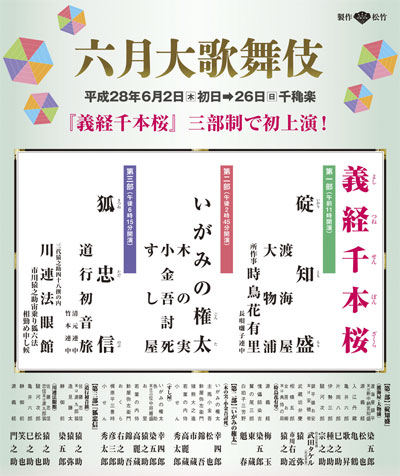| JUNE 2016 |
|
5 shows in T˘ky˘ (Kabukiza, National Theatre, Theatre Cocoon) and 2 in Fukuoka (Hakataza)!
|
| Kabukiza (T˘ky˘) |  |
| Dates | 2 ~ 26 June 2016 (Rokugatsu ďkabuki) June Grand Kabuki |
| MatinÚe |
Yoshitsune Senbon Zakura (Ikari Tomomori)
Hototogisu Hana Aru Sato |
| Afternoon |
Yoshitsune Senbon Zakura (Igami no Gonta)
|
| Evening |
Yoshitsune Senbon Zakura (Kitsune Tadanobu)
|
| Casting |
Matsumoto K˘shir˘, Nakamura Baigyoku, Nakamura Kaishun, Ichikawa Somegor˘, Ichikawa Ennosuke, Onoe Matsuya, Nakamura T˘z˘, Matsumoto Kingo, Ichikawa Komaz˘, Ichikawa Unosuke, Band˘ Hikosabur˘, Kataoka Hidetar˘, Ichikawa Monnosuke, Ichikawa Emiya, Nakamura Kikaku, Nakamura Kash˘, Band˘ Minosuke, Ichikawa Ukon, Ichikawa En'ya, Nakamura Tanenosuke, Takeda Takeru |
| Comments |
The classic "Yoshitsune Senbon Zakura" is staged in 3 parts and Ichikawa Ukon's son Takeda Takeru makes his first stage appearance (omemie) in the role of Rokudai. Each part of "Yoshitsune Senbon Zakura" is dedicated to one hero of this drama: Taira no Tomomori in the first part, Igami no Gonta in the second part and Tadanobu in the third part. In the first part, Masuyama Kinpachi I's Nagauta-based drama "Hototogisu Hana Aru Sato" is revived. This dance-drama is commonly called "Tadanobu" and it stars Nakamura Baigyoku and Nakamura Kaishun in the roles of Minamoto no Yoshitsune and the shiraby˘shi Miyoshino.
|
 |
|
|||
| Dates | 2 ~ 26 June 2016 (Rokugatsu Hakataza ďkabuki) June Hakataza Grand Kabuki |
||
| MatinÚe |
Kimi-ga-Yo Sh˘chikubai |
||
| Evening | |||
| Casting |
Nakamura Jakuemon, Living National Treasure Sakata T˘jűr˘, Living National Treasure Kataoka Nizaemon, Living National Treasure Onoe Kikugor˘, Nakamura Tokiz˘, Onoe Kikunosuke, Kataoka Takatar˘, Onoe Sh˘roku, Ichikawa Danz˘, ďtani Tomoemon, Nakamura Kinnosuke, Ichikawa Sadanji, Nakamura Karoku, Band˘ Takesabur˘, Kawarasaki Gonjűr˘, Band˘ Kamesabur˘, Band˘ Kametoshi, Nakamura Yonekichi, ďtani Hirotar˘, ďtani Hiromatsu, Kataoka Matsunosuke, Onoe Ukon |
||
| Comments |
Nakamura Jakuemon V celebrates his shűmei in Fukuoka at the Hakataza!
|
||
|
|||
| Dates | 6 ~ 29 June 2016 | ||
| Program | |||
| Casting |
Nakamura Kankur˘, Nakamura Shichinosuke, Nakamura Senjaku, Nakamura Shid˘, Kataoka Kamez˘, Nakamura Tsurumatsu, Sasano Takashi, Manako Keiji, ďmori Hiroshi |
||
| Comments |
15th edition of the original Cocoon Kabuki performance, which recreates the atmosphere of the Edo koshibai and brings the actors closer to the audience. The play "Yotsuya Kaidan" is revised by the playwright Kushida Kazuyoshi and this new production is based on the second version (kitaban), which was staged in March 2006/April 2006 in the same theater and included the rarely-staged act IV, with its 2 scenes "the Misumi House in Fukagawa" and "the Refuge of the Oshioda Family" [more details].
|
||
 |
| National Theatre (T˘ky˘) |
| Dates | 2 ~ 24 June 2016 (Rokugatsu Kabuki Kansh˘ Ky˘shitsu) June Kabuki Appreciation Class |
| Program | |
| Casting |
Nakamura Hashinosuke, Nakamura Baishi, Nakamura Mantar˘, Nakamura Muneo |
| Comments |
Educational program at the National Theatre called Kabuki Kansh˘ Ky˘shitu ('Kabuki Appreciation Class'). This is a very interesting formula for the beginners because there is lively presentation on stage of Kabuki or some aspects of the art like music, stage tricks or fighting scenes. It is followed by the drama "Sakanaya S˘gor˘". |
|
|
| Contact | Main | Top | Updates | Actors | Plays | Playwrights | Programs | Links | FAQ | Glossary | Chronology | Illustrations | Prints | Characters | Derivatives | Theaters | Coming soon | News |

